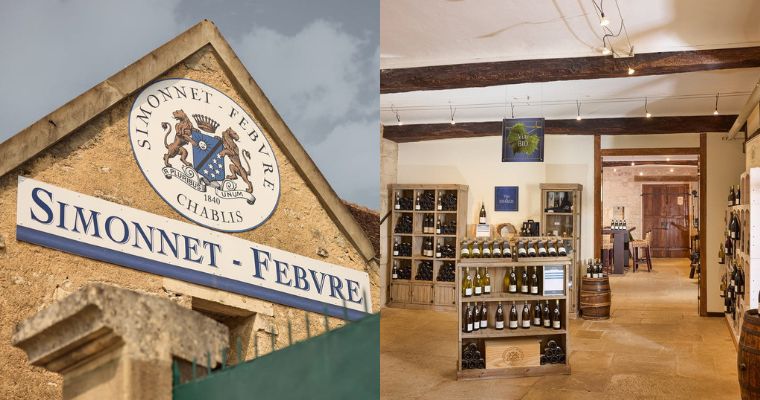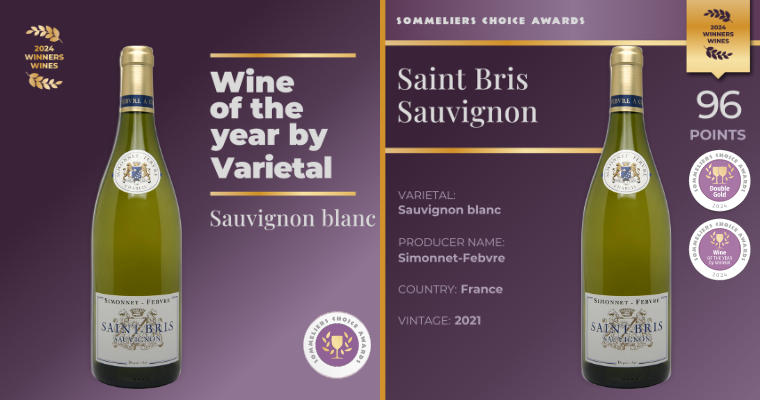Super Early Bird Deadline
October 31, 2025
Judging
Date
May 18, 2026
Winners
Announced
June 10, 2026

Louis Latour is not your run-of-the-mill French wine company, and its subsidiary Simonnet-Febvre has successfully applied its entrepreneurial strategy in Chablis and surrounding areas. This includes dedication to producing a variety of wines from different geographic origins, using unconventional varieties, and creating products at various price points and appellation hierarchies. Looking at the two houses demonstrates a careful balancing of tradition with innovation, which may include using tradition as a source of innovation in today’s marketplace.
What does “being entrepreneurial” mean within the corporate context and the wine industry? A little-known fact is that an eighteenth-century wine merchant and banker, the Irishman Richard Cantillon, actually invented the modern definition of an entrepreneur. Cantillon sold claret from Bordeaux, wines from Auxerre, and champagne.
He “cast the entrepreneur as an arbitrageur, one who bridges gaps between demand and supply, hoping for a right guess that would pay off but knowing that a mistake would inflict losses,” says one economics expert, Professor. Hébert. For Cantillon, both traders and winemakers could be entrepreneurs, defined as “the bearer of risks inflicted by the changes in demand that they face in the market,” notes Mark Thornton of the Mises Institute. “ He speaks of the entrepreneur in the classic sense of the undertaker of great business adventures but he also has a theoretical distinction between those who work for a fixed return or wages and those who face uncertain returns including farmers, independent craftsmen, merchants and manufacturers. These entrepreneurs purchase inputs at a given price to produce and sell later at an uncertain price. In the pursuit of profit, the entrepreneur must bear risks as he faces the pervasive uncertainty of the market.
In the 20th century, Cantillon influenced Schumpeter, who emphasized, in a novel way, the importance of innovation in defining entrepreneurship. “Schumpeterian economic development is a process that requires an engine and a driver. The engine is ‘creative destruction.’ The driver is the entrepreneur redefined as an innovator.” Later, “Nobel laureate Theodore Schultz proposed his ‘everyman’ concept of entrepreneurship, defining it broadly as ‘the ability to deal with disequilibria’.” As Hébert notes, “Using different words, Richard Cantillon had said as much 220 years earlier.”
In the end, entrepreneurship lacks a generally accepted definition, but, as a “multidimensional concept,” it clearly involves “aspects of uncertainty-bearing, innovation, opportunity-seeking, management, and enterprising individuals” according to one group of experts. “It combines a focus on the market, generation of creative insights, identification of new opportunities and sources of innovation, ability to take risks, resource leveraging as well as a style of marketing behavior driven and shaped by owner/managers personality and characteristics,” say others.
To be entrepreneurial within a corporate context requires applying these attributes in terms of company business strategy, which in the wine business can encompass numerous factors and a need to focus on long-term returns with an adept, but long-term vision.
Is Simonnet-Febvre, and with it, Maison Louis Latour, an entrepreneurial company within today’s global wind industry?
Founded in 1797 in the Côte de Beaune, Maison Louis Latour highlights its “dedication to showcasing the true terroir of Burgundy” writ large. Beyond that, the company has a deep commitment to sustainable production and the well-being of its growers and producers. Louis Latour remains family-owned and -run since its founding. Innovative approaches include, for example, planting the local white grape Auxerrois as well as Pinot Noir at vineyards with clay-limestone soils at between 280 and 380 meters in altitude, in the current home of the Gamay Noir grape, Beaujolais. Louis Latour is not confined by relatively recent conventions.
This heritage will continue. This year, Eléonore Latour, a 12th-generation Latour family member, was named corporate Vice President. Meanwhile, bringing in fresh ideas, Francois Beall was named Vice President of Sales of Louis Latour Inc., the company’s wholly-owned U.S. subsidiary.
“We like to say that Louis Latour is the wine that accompanies you through life and Eléonore and Francois represent the next generation, bringing a fresh perspective on how people enjoy wine today as well as a deep understanding of our company and industry,” said Louis Latour CEO Florent Latour, also remarking on the importance of “heritage and innovation.”
Eléonore Latour is the first female Latour family member to join the company. She studied commercial law at Paris-Dauphine and now follows in the footsteps of her father, Louis-Fabrice Latour, who served as CEO from 1999-2022, significantly expanding operations while acting as a Burgundy region ambassador. “You’re never far from the business when you grow up in Burgundy and I’m honored to have the opportunity to play a role in Louis Latour’s future, bringing the specialness of the Burgundy region and our high-quality wines to more people,” Ms. Latour commented.

Image: Chablis cellars
Francois Beall offers the benefits of substantial experience working with leading wine suppliers, importers, and distributors, most recently leading sales and marketing in Southern California for Chambers & Chambers Wine Merchants. Previously, Beall spent several years in sales and marketing roles at Ste. Michelle Wine Estates, including managing the company’s Luxury portfolio in Southern California.
One of the subsidiaries these two women are focused on is Simmonet-Febvre. Founded by Jean Febvre, a cooper, in 1840, Maison Simonnet-Febvre is a traditional Chablis winery and amongst the oldest in the area. Jean specialized in making sparkling Chablis, the ancestor of Crémant de Bourgogne. It became Simonnet-Febvre in 1894. The Crémant grapes still come from the slopes of the Grand Auxerrois area, located a few kilometers away from the famous Chablis vineyards. Ironically, the fourth-generation Louis Latour celebrated the purchase of the Château Corton with bottles of Sparkling Chablis from Simonnet-Febvre. These bottles were ordered on December 8th, 1891, which was 112 years before Louis Latour finally purchased the company.
Today, the company’s wines include not only high-quality Crémant but also Chablis, Grand Auxerrois, and Coteaux de l'Auxois appellations, an extraordinarily diverse offering. For the latter, the company created, from scratch, the rebirth of a great vineyard area that had long been abandoned. Forgotten since the 19th century, the area of the Auxois finally received Indication Géographique Protégée "Coteaux de l'Auxois" certification in 1996. The winery started with 15 hectares of vineyards in the villages of Villaines-les-Prévôtes and Viserny. One of Maison Simonnet-Febvre’s priorities is to develop the Coteaux de l'Auxois and reinvigorate the area. The 25+-year-old vines enjoy beautiful southeasterly exposures, trained in lyre style and only hand-picked.
Simonnet-Febvre is the only one in Chablis to perpetuate since its earliest days the production of sparkling wines using the traditional méthode Champenois. This wine is now called Crémant de Bourgogne.
From Grand Auxerrois, very close to Chablis, come a variety of wines, including a broad and intriguing range of appellations and varietals. This is definitely an appellation that sommeliers should keep an eye on. Maison Simonnet-Febvre, for instance, produces wines from the historic Yonne vineyards that were destroyed when the phylloxera crisis hit the area in the late 19th century. It has progressively been replanted and thanks to Simonnet-Febvre, has now regained well-deserved prestige.
Village appellations include Saint-Bris, Irancy as well as regional appellations such as Bourgogne Epineuil made of Pinot Noir, Bourgogne Vézelay made of Chardonnay, and Bourgogne Aligoté made the eponymous grape. Irancy red wine comes from vineyards planted on marl-rich slopes. It is made of a blend of Pinot Noir with a maximum of 10% César. This is an unusual and ancient grape variety that gives a depth of ruby color, with red fruit aromas and smooth tannins.

Image: 2024 Sommeliers Choice Awards Winner - 2021 Saint-Bris
Then there is Saint-Bris. Surprisingly, This wine is not made from Chardonnay, the white grape of nearby Chablis. Rather it is 100% Sauvignon Blanc, like Sancerre. The location of the Saint-Bris vineyards allows this grape to fully express its aromatic range as well as the soil’s minerality. Vines are often planted in colder areas, contributing to slow ripening and therefore “the best expression of the vineyards' strong character.” Simonnet-Febvre says of the 2022 vintage, “This wine has a pale straw color and its lively aromas are characterized by the scent of bruised blackcurrant leaves. It also has aromas of exotic fruits, freshly-cut grass, and citrus fruits.”
Being entrepreneurially oriented includes marketing aptitude. Simmonet-Febvre entered the 2021 Saint-Bris in the 2024 Sommeliers Choice Awards to showcase its suitability for the on-premise trade. Here wines are judged by expert sommeliers for their suitability for restaurant wine programs, both by the bottle and the glass. This process not only qualifies the wine as perfect for restaurant service but also introduces it to a powerful network of Somms and wine directors.
In awarding it 96 points out of 100 and a double gold medal, the Awards’ judges describe the 2021 Saint-Bris as “featuring a bright nose of butter, apple, peach, and citrus.” They concluded: “This wine presents brie rind and apple upfront, with lemon juice, dried stone fruit, and a finish of goat cheese, lemon peel, and tart brioche.”
An exciting, sophisticated Sauvignon Blanc coming from Grand Auxerrois, this unknown northern region of France, and a storied property, make for great and memorable storytelling, a key aspect of the sommelier’s sales approach. This wine, again, shows how Simonnet-Febvre and Louis Latour will invest in entrepreneurial innovation, but based on history and tradition.
In conclusion, Simonnet-Febvre exemplifies the entrepreneurial spirit of Maison Louis Latour by seamlessly blending tradition with innovation. The winery’s commitment to revitalizing forgotten vineyards, producing a diverse range of appellations, and introducing trailblazing wines like the Saint-Bris Sauvignon Blanc showcases its forward-thinking approach. This innovative mindset, deeply rooted in a rich heritage, ensures that both Simonnet-Febvre and Louis Latour continue to lead and inspire within the global wine industry, offering wines that captivate both sommeliers and consumers alike. The man who defined what an entrepreneur is and who knew Auxerre well, Richard Cantillon, would be proud of his wine industry colleagues!
Header Image: Simonnet - Febvre
Enter your Wines now and get in front of top Sommeliers, Wine Directors, and On-Premise Wine Buyers of USA.
